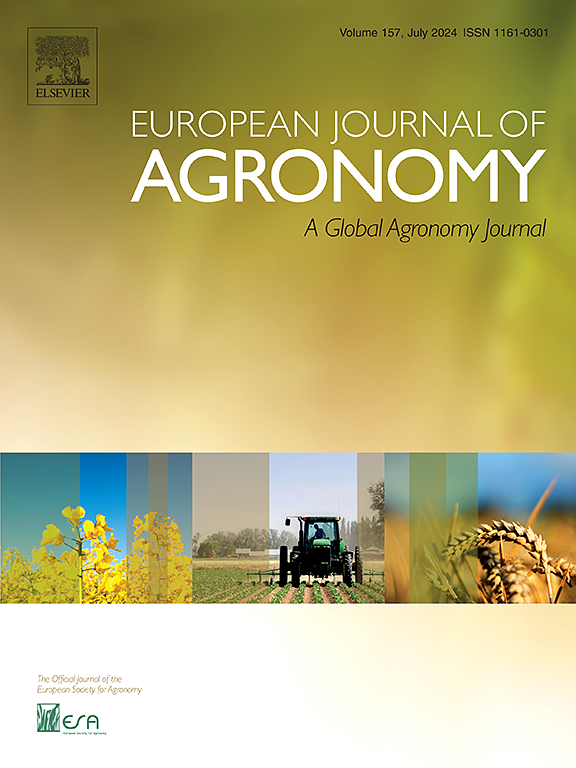高效作物分割网和新型杂草检测方法
IF 4.5
1区 农林科学
Q1 AGRONOMY
引用次数: 0
摘要
基于计算机视觉的精准杂草控制为减少除草剂投入和杂草管理的相关成本提供了一条前景广阔的途径。然而,收集和标注杂草图像数据需要投入大量的时间和人力,这给开发有效的深度学习模型带来了挑战。此外,在田间不同生长阶段、不同密度和不同生态类型的杂草中实现准确可靠的检测也是一大挑战。为解决这些问题,本研究调查了一种新型方法,该方法采用分割算法准确标记图像中作物的轮廓信息,并通过图像处理技术检测杂草。此外,还开发了基于 YOLO 架构的新型分割网络,以解决与分割算法相关的大量计算资源需求。这是通过设计新的骨干网、加入关注机制和修改特征融合技术来实现的。新型网络以更低的计算需求实现了更高的分割精度。此外,还研究了三种不同注意力模块在分割任务中的有效性。实验结果表明,"十字交叉注意力 "的加入显著提高了模型的性能,并随后被纳入我们的增强型方法中。增强型模型的平均联合交叉率(mIoU50)达到了 90.9%,精确度提高了 5.9%,每秒千亿 FLoating-point 运算次数(GFLOPs)减少了 15.56%,表明该模型更适合部署在资源有限的计算环境中。本研究的发现对精确杂草管理具有重要的理论和实践意义。本文章由计算机程序翻译,如有差异,请以英文原文为准。
Efficient crop segmentation net and novel weed detection method
Computer vision-based precision weed control offers a promising avenue for reducing herbicide input and the associated costs of weed management. However, the substantial investments in time and labor required for the collection and annotation of weed image data pose challenges to develop effective deep learning models. The limitation also stems from the challenges in achieving accurate and reliable detection of weeds across varying growth stages, densities, and ecotypes in field scenarios. To address these issues, this research investigated a novel methodology employing a segmentation algorithm to accurately mark the contour information of crops in the image and detect weeds through image processing technology. Furthermore, a novel segmentation network was developed based on the YOLO architecture to address the substantial computing resource demands associated with segmentation algorithms. This was achieved through the design of a new backbone, incorporation of an attention mechanism, and modification of the feature fusion technique. The novel network achieved higher segmentation accuracy with less computational demands. The effectiveness of three different attention modules on segmentation tasks was additionally investigated. Experimental results showed that the insertion of Criss-cross Attention significantly improved the model's performance and was subsequently incorporated into our enhanced methodology. The enhanced model achieved a Mean Intersection over Union (mIoU50) of 90.9 %, with precision increasing by 5.9 % and Giga FLoating-point Operations Per Second (GFLOPs) reduced by 15.56 %, demonstrating enhanced suitability for deployment in resource-constrained computing environments. The findings presented in this study hold substantial theoretical and practical implications for precise weed management.
求助全文
通过发布文献求助,成功后即可免费获取论文全文。
去求助
来源期刊

European Journal of Agronomy
农林科学-农艺学
CiteScore
8.30
自引率
7.70%
发文量
187
审稿时长
4.5 months
期刊介绍:
The European Journal of Agronomy, the official journal of the European Society for Agronomy, publishes original research papers reporting experimental and theoretical contributions to field-based agronomy and crop science. The journal will consider research at the field level for agricultural, horticultural and tree crops, that uses comprehensive and explanatory approaches. The EJA covers the following topics:
crop physiology
crop production and management including irrigation, fertilization and soil management
agroclimatology and modelling
plant-soil relationships
crop quality and post-harvest physiology
farming and cropping systems
agroecosystems and the environment
crop-weed interactions and management
organic farming
horticultural crops
papers from the European Society for Agronomy bi-annual meetings
In determining the suitability of submitted articles for publication, particular scrutiny is placed on the degree of novelty and significance of the research and the extent to which it adds to existing knowledge in agronomy.
 求助内容:
求助内容: 应助结果提醒方式:
应助结果提醒方式:


